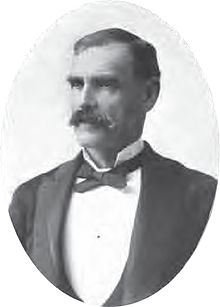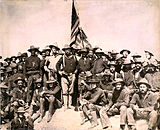Alexander Oswald Brodie
Alexander Brodie | |
|---|---|
 | |
| 15th Governor of Arizona Territory | |
| In office July 1, 1902 – February 14, 1905 | |
| Nominated by | Theodore Roosevelt |
| Preceded by | Oakes Murphy |
| Succeeded by | Joseph Henry Kibbey |
| Personal details | |
| Born | November 13, 1849 Edwards, New York |
| Died | May 10, 1918 (aged 68) Haddonfield, New Jersey |
| Political party | Republican |
| Spouses | Kate Reynolds (m. 1877)Mary Louise Hanlon
(m. 1864–1918) |
| Military service | |
| Branch/service | |
Alexander Oswald Brodie (November 13, 1849
Background
Alexander O. Brodie was a lineal descendant
As a newly commissioned officer, Brodie was assigned to
After leaving the military, Brodie worked as a cattleman in
On December 15, 1892, Brodie married Mary Louise Hanlon.
Spanish–American War

On March 3, 1898, with the outbreak of war between Spain and the United States appearing likely, Brodie sent
Following training in San Antonio, Texas, Brodie's unit was deployed to Cuba. On June 24, 1898, during the Battle of Las Guasimas, he was wounded by a bullet in his right wrist. Initially refusing to leave the battle, Major Brodie was eventually forced from the field by pain and blood loss. He was evacuated from Cuba and treated in the hospital at Fort Wadsworth, New York.[11] After recovering from his wound, Brodie returned to the Rough Riders on August 11, 1898, and, being promoted to lieutenant colonel, succeeded Theodore Roosevelt as unit commander.[12] Brodie himself mustered out on September 15, 1898, and returned to Arizona Territory to work as a mining engineer.[13]
Governorship
Following the resignation of Oakes Murphy as Governor of Arizona Territory, Brodie was nominated for the position and sworn into office on July 1, 1902.[13] His first several months were spent appointing new officials and organizing his administration. An action of note prior to the convening of the 22nd Arizona Territorial Legislature was the pardon of Pearl Hart on moral grounds.[14] At the time, the outlaw was the only female at the Yuma Territorial Prison and her presence was causing disruptions as guards and other prisoners vied for her attentions. The December 1902 pardon was made on the condition that Hart leave the territory, a condition she quickly fulfilled. Another display of the new Governor's ethical stance was his refusal to use a US$750 discretionary fund which was available for his personal use. Brodie considered the legislative appropriation which created the fund illegal as it had no oversight provisions to prevent misuse.[15]

With the start of the 22nd Legislature in January 1903, Brodie requested several changes to the territorial
Between legislative sessions, Brodie was responsible for expanding the size of the
Brodie announced his resignation as governor on February 14, 1905. As a token of their esteem the Democratically controlled legislature presented the Republican governor a ceremonial saber.[22]
After office
Following his resignation as governor, Brodie returned to the U.S. Army at the rank of major. After serving briefly in the War Department's record and pension office, he was assigned to the Philippines serving on a board overseeing the Friar lands dispute. In 1907 he was made adjutant general of the Department of the Dakotas and in 1911 was transferred to the Department of California to perform the same job. Bordie was promoted to colonel in 1912 and retired from the military in 1913.[23]
Brodie moved to Haddonfield, New Jersey, where he settled at Greenfield Hall. Brodie died on May 10, 1918, and was buried in Arlington National Cemetery.[23]
Notes
Footnotes
- ^ "Commercial Advertiser. Potsdam Junction, N.Y." Commercial Advertiser. February 14, 1905. Archived from the original on April 11, 2019. Retrieved October 16, 2016.
- ^ See his Clan's family tree and also Tables XVI. Brodie & XVIII. Royal Descent, which give Brodie's family tree back to King Robert I (“The Bruce”) and the Scottish Royal House in: Watson, Charles B. Boog. Alexander Cowan of Moray House and Valleyfield (founder of A. Cowan & Sons), His Kinsfolk and Connections. D. Leslie (Watson & Annandale), Perth, 1915-1917 - Available Online
- ^ Watson, Charles B. Boog. Alexander Cowan of Moray House and Valleyfield (founder of A. Cowan & Sons), His Kinsfolk and Connections. D. Leslie (Watson & Annandale), Perth, 1915-1917, p. 39 - Available Online
- ^ a b c Goff 1978, p. 175.
- ^ a b c "Alexander Brodie: A governor for all seasons". The Prescott Courier. June 4, 1981. pp. 12–15.
- ^ Wagoner 1970, p. 396.
- ^ Goff 1978, pp. 175–6.
- ^ a b c d Goff 1978, p. 176.
- ^ Liggett, James A. “Arizona’s Worst Disaster, The Hassayampa Story (1886–2009)” (Pathfinder Publishing), p.55
- ^ Wagoner 1970, pp. 396–7.
- ^ a b c d e Goff 1978, p. 177.
- ^ Goff 1978, pp. 177–8.
- ^ a b Goff 1978, p. 178.
- ^ Wagoner 1970, p. 399.
- ^ Wagoner 1970, p. 400.
- ^ Wagoner 1970, p. 403.
- ^ Wagoner 1970, p. 404.
- ^ Wagoner 1970, p. 406.
- ^ Wagoner 1970, p. 381.
- ^ Wagoner 1970, p. 417.
- ^ Goff 1978, p. 183.
- ^ Wagoner 1970, p. 418.
- ^ a b Goff 1978, p. 185.
References
- Goff, John S. (1978). Arizona Territorial Officials Volume II: The Governors 1863–1912. Cave Creek, Arizona: Black Mountain Press. OCLC 5100411.
- Liggett, James A. (2009). Arizona's Worst Disaster, The Hassayampa Story 1886–2009. Wickenburg, Arizona: Pathfinder Publishing. ISBN 978-0-9765591-2-2.
- Wagoner, Jay J. (1970). Arizona Territory 1863–1912: A Political history. Tucson: University of Arizona Press. ISBN 0-8165-0176-9.
External links
- Buckey was charismatic, but Brodie was the Rough Riders' glue from Sharlot Hall Museum
- Alexander Oswald Brodie, Arlington National Cemetery
- Alexander O. Brodie from Cullum's Register of Officers and Graduates of the United States Military Academy Class of 1870


